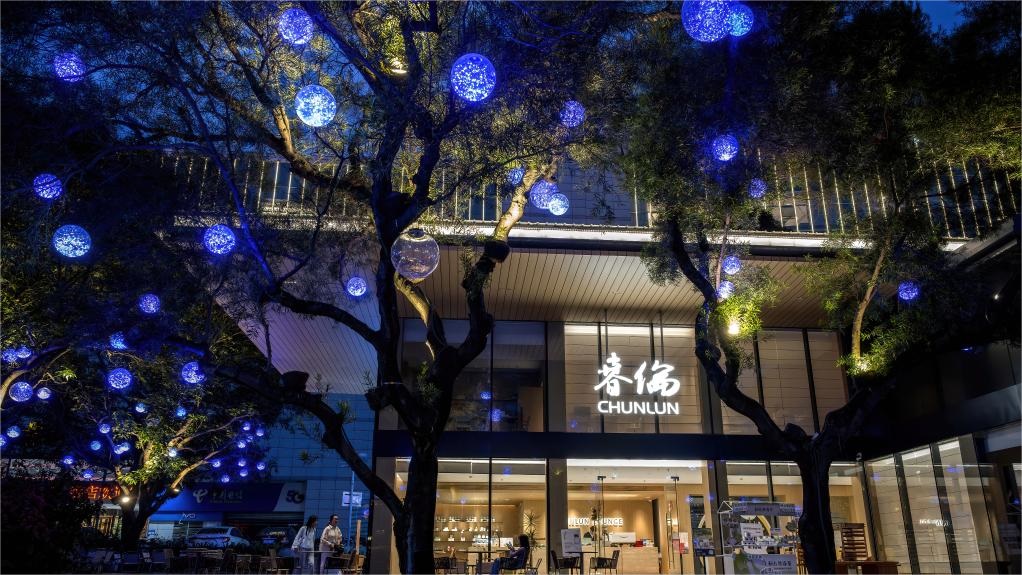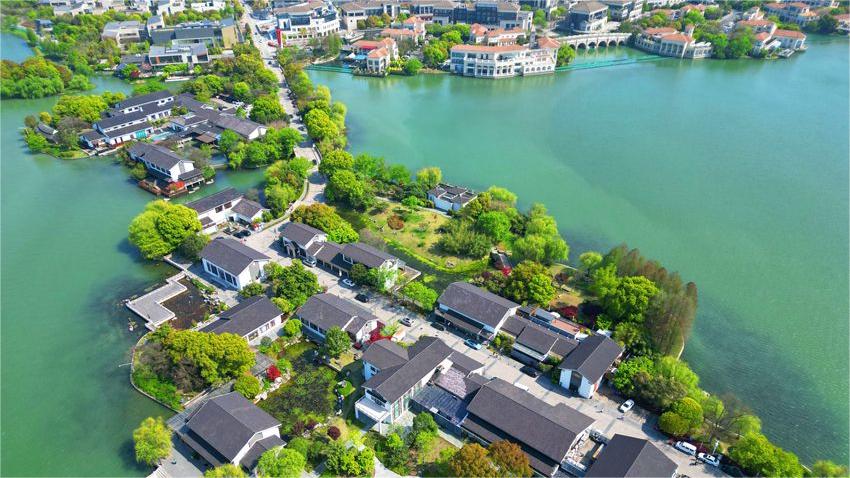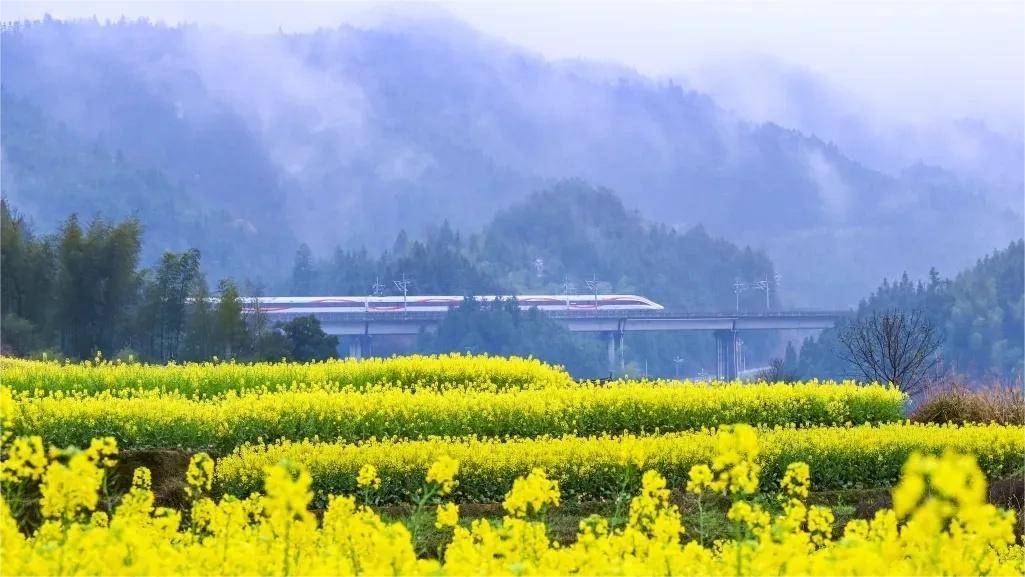Rwanda's rebirth -- a nation of unity emerges from shadow of genocide
KIGALI, April 17 (Xinhua) -- During a ceremony at the Kigali Genocide Memorial on April 7, Rwandan President Paul Kagame and First Lady Jeannette Kagame lit a memorial torch, a flame of remembrance set to burn for 100 days as a solemn tribute to the tragedy that occurred three decades ago.
On April 7, 1994, Rwanda plunged into darkness as nearly 1 million Rwandans, predominantly Tutsis, fell victim to brutality in three months. Hutu militias unleashed a wave of terror, perpetrating beatings, torture, rape, and murder against Tutsi civilians, including numerous women and children.
The genocide, tearing apart communities of Hutus and Tutsis who shared the same language and religion, found its roots in the colonial policies of Western powers. The seeds of division were sown through the colonial scheme of "divide and rule."
WE CAN'T TELL OURSELVES APART
Nestled in the heart of Africa, Rwanda is known as the "land of a thousand hills." Its breathtaking scenery boasts rolling hills adorned with serene lakes and meandering rivers nourishing lush greenery.
The Hutu and Tutsi communities have long coexisted as predominant ethnic groups. The Hutu, primarily agrarian, constitute the majority of the population, while the Tutsi, the sizeable minority, traditionally engage in livestock herding. For generations, the two communities have intermingled, living in mixed settlements and often intermarrying.
"Before the arrival of the colonizers, Rwandans were living in total harmony, where Hutu, Tutsi and Twa each played their role in the society," said Jean-Baptiste Gasominari, a Rwandan political analyst.
Rwanda's fate took a drastic turn with the arrival of European colonizers, first the Germans and later the Belgians, in the late 19th century. Employing the ruse of racial classification, the colonizers shattered the longstanding harmony between the two ethnic groups.
According to the flawed contrivance, Europeans deemed themselves superior to Africans, designating Tutsis, with physical features closer to Europeans, as the "superior race" and enlisting them as proxies for governance.
Western anthropologists, in their quest for categorization and control, scrutinized the skulls, facial features, and body types of the indigenous population. Minute differences, such as the length and width of the nose, were perceived as ethnic markers. Consequently, since 1933, Belgian colonial authorities enforced the divisive labeling of Rwandans as either "Hutu" or "Tutsi" on their identity cards.
"You can't tell us apart, even we can't tell us apart," Laurent Nkongoli, then vice president of the National Assembly, who is Tutsi, told American writer Philip Gourevitch, saying he was treated as "one of them" in a Hutu settlement.
"Hutus and Tutsis were once social classes, but the colonizers transformed these identities into political tools," said Ladislas Ngendahimana, the secretary general of the Rwanda Association of Local Government Authorities.
DIVISION CREATED BY COLONIZERS
Mahmood Mamdani, a Ugandan academic, delves into the ploy employed by colonial powers known as indirect rule, a tactic that sought not to eradicate but to redefine existing differences between conquerors and the conquered.
Initially, colonizers attempted direct control over their colonies but encountered formidable resistance rooted in entrenched social traditions.
Henry Maine, a British jurist, devised the infamous "divide and rule" scheme to salvage British authority in India. The Machiavellian approach exploited existing divisions among local populations based on race, language, culture, and religion. By co-opting select groups and nurturing indigenous elites to administer colonial rule on their behalf, colonizers intended to deflect resentment away from themselves.
This practice has since been adopted across the globe, from the British-controlled Malay Peninsula and Dutch-ruled Indonesia, and gradually extended to Egypt, Sudan and other African nations.
Yet, "divide and rule" evolved beyond mere polarization of native populations; it morphed into a deliberate effort to redefine Africa. Western powers crafted narratives, fabricating traditional cultures and distorting historical truths to justify their domination.
In Rwanda, the colonial manipulation manifested the preferential treatment of Tutsis in military and political spheres, while systematically suppressing Hutus. Tutsi's dominance was enforced, with Hutu chiefs replaced and educational opportunities limited for Hutu youth.
"The colonizers did not just exacerbate the division, but they created it," said Gasominari. "It's difficult for the colonizers to root a unified and peaceful country, so they divided African countries, weakened us and took away our minerals and gold."
THE COLONIZED TURNED AGAINST EACH OTHER
In the wake of World War II, the Belgian colonial administration, sensing the tide of anti-colonial sentiment, sought to align itself with the burgeoning Hutu populace, positioning themselves as arbiters in the escalating ethnic tensions.
"The last battle of the colonized against the colonizers will often be the fight of the colonized against each other," observed Frantz Fanon, a French writer and revolutionary.
In 1959, the "social revolution" erupted in Rwanda, as Hutu resentment boiled over into violence against Tutsis. Hundreds of thousands of Tutsis, including the two-year-old Paul Kagame, were forced into exile.
As the Belgian authorities lost their grip on power, they lent their support for the Hutus, paving the way for their resounding victory in the 1960 local elections.
After its independence in 1962, Rwanda's new government expelled Tutsis from the political sphere, barring them from higher education and gainful employment.
Jacqueline Mukamana, a Tutsi survivor of the 1994 Genocide, recalls the moment she became aware of her identity: "I didn't realize I was Tutsi until I faced discrimination in school, with policies favoring Hutu children."
In October 1990, the Rwanda Patriotic Front (RPF), comprised of Tutsi exiles from Uganda, clashed with Rwandan government forces, demanding their right to return home and be recognized as Rwandan citizens.
Amidst the escalating tensions, external actors further complicated the situation. France, vying for influence in Africa, threw its support to the pro-French Hutu regime, providing arms and training to quell the Tutsi forces, which had close ties to former British colonies like Uganda.
In August 1993, the Rwandan government, led by Hutu President Juvenal Habyarimana, and the RPF signed the Arusha Accords to address key issues such as power-sharing and refugee repatriation in a bid to end the protracted civil war.
On April 6, 1994, the tragic assassination of Habyarimana and Burundian President Cyprien Ntaryamira in a plane crash near Kigali airport served as the catalyst that ignited the powder keg of conflict in Rwanda, plunging the nation into its darkest hour.
CUT DOWN THE TALL TREES
In the chaotic aftermath of the presidential plane crash, Hutu extremists spared no time seizing control and forming an interim government. Across Kigali, army units and Hutu militias erected roadblocks, scrutinizing the racial classifications on people's identity cards.
The orchestrated massacres commenced. The airwaves crackled with the venomous broadcasts of Radio Television Libre des Mille Collines (RTLM) vilifying Tutsis as "cockroaches" and goading Hutus to "cut down the tall trees."
Armed with machetes and fueled by hate-filled rhetoric, Hutu civilians descended upon their Tutsi neighbors, unleashing a wave of carnage that engulfed the city. Within a week, the streets of Kigali ran red with the blood of 20,000 victims.
The horror swiftly spread across the country, as years of intermingling among villagers rendered them acutely aware of their neighbors' ethnic identities. Tutsis seeking shelter in fields, forests, swamps, and hills found no refuge from the relentless onslaught.
"I lost 65 family members. In the end, we managed to find and bury 21 of them," Mukamana escaped and returned to the grisly sight of her family's massacre.
Alongside other survivors, she fled to seek refuge in the neighboring Nyamata Church, which was packed with fearful, desperate civilians. "We thought no one would kill anyone in the church, but soon the militia came and attacked it with grenades and guns."
For 100 days, Rwanda descended into a maelstrom of violence and despair. Blood flowed freely, staining homes, fields, and roads with the grim testament of genocide. Public infrastructure lay in ruins, and the specter of death loomed large, casting a dark pall over the nation.
A survivor's grievance is showcased on the wall of the exhibition hall at the Kigali Genocide Memorial Center: "When they said 'Never again' after the Holocaust, was this meant for some people and not for others?"
BETRAYAL BY INT'L COMMUNITY
"It was the international community which failed all of us, whether from contempt or cowardice," Kagame said in his speech at the ceremony marking the 30th anniversary of the genocide.
"When we talk of the international community, basically it means the powerful countries, the Western world," Ngendahimana said.
When the tragedy occurred in 1994, U.S. officials hesitated to invoke the term "genocide," dodging the legal obligations that would ensue under the Genocide Convention adopted by the United Nations.
As then U.S. President Bill Clinton said in a speech during the 100 days: "Whether we get involved in any of the world's ethnic conflicts in the end must depend on the cumulative weight of the American interests at stake."
It was in July 1994, when the Kagame-led RPF took control of Kigali and soon the whole country, that the 100-day tragedy ended.
Yet, even as Rwanda grappled with the aftermath of genocide, the echoes of colonialism continued to reverberate across the African continent.
Ngendahimana said that the divisionism brought about by colonial rule still had a deleterious effect on African countries. "We were forced to reject our values, language and identity and embrace a foreign identity, and this colonial legacy has sparked conflicts and wars in African countries such as Nigeria, Cameroon, Somalia, Sudan and others."
EMBRACING FORGIVENESS AND RECONCILIATION
In July 1994, a Government of National Unity was established by the RPF, comprising both Hutu and Tutsi officials, marking a pivotal step towards transcending the deep-seated divisions that had torn the nation asunder.
Central to the reconciliation efforts was the overhaul of the constitution, which saw the removal of ethnic categories from identity cards. No longer were Rwandans defined by Hutu or Tutsi labels; instead, they embraced a shared identity as Rwandans, united in their common humanity.
In the wake of the atrocities, the country faced a severe shortage of judges capable of adjudicating the staggering number of cases. With over 100,000 individuals accused of participating in the genocide, the Rwandan government sought innovative solutions to deliver justice and facilitate recovery.
Thus, the Gacaca courts emerged as a unique and transformative mechanism for reconciliation. Held in community settings, these grassroots tribunals provided a platform for victims and perpetrators alike to confront the truth, seek forgiveness, and foster understanding.
Mukamana also attended the courts. "The perpetrators told me the truth, they asked for forgiveness, said they had been misled by the genocidal regime, informed me of the place where they dumped the remains of my family members. I managed to find the remains of my relatives and gave them a decent burial."
Since their inception in 2002, over 12,000 Gacaca courts have convened across Rwanda, adjudicating more than 1.9 million cases.
REBIRTH FROM ASHES
With a stable political landscape, sound security and a commitment to transparent governance, Rwanda has achieved remarkable economic and social development in recent years.
According to the World Bank, Rwanda's economy has registered remarkable growth, with an average annual rate of 7.2 percent and a corresponding rise in GDP per capita by 5 percent between 2009 and 2019. Kigali received the UN-Habitat Scroll of Honour award in 2008, becoming the first African city to earn the prize.
Drawing inspiration from local traditions of communal support, Rwanda has pioneered a series of "Home Grown Solutions" aimed at accelerating socio-economic development. The "Girinka" program, for instance, distributes cows to impoverished families, with the proviso that the first calf born is gifted to a neighboring family, fostering both economic empowerment and social cohesion.
Mukamana created a cooperative called Duterimbere with a dozen women in the village, selling hand-made decorations to subsidize their families. "Duterimbere means 'to go forward with enthusiasm'," she said, "our village was reborn from the ashes of genocide."
"After the devastation of 1994, Rwanda faced a crossroads," observed Gasominari. "Yet, through deliberate choices of reconciliation, reconstruction, and national renewal, Rwanda has emerged as a shining example of resilience and progress."
As a member of the global South, strengthening South-South cooperation is an important direction for Rwanda's external engagement. The government-funded Rwanda Cooperation Initiative was established in 2018 to showcase Rwanda's transformative innovations to global partners and to strengthen exchanges and cooperation among developing countries in their quest for development.
In 2018, Rwanda joined the China-proposed Belt and Road Initiative. According to statistics, the highways built by Chinese enterprises account for more than 70 percent of the country's total mileage, becoming the arteries of Rwanda's economic and social development, interconnecting the landlocked country and connecting it to its neighboring countries.
"I commend the manner in which China engages with Africa, including its collaboration with Rwanda. The Forum on China-Africa Cooperation, initiated by China, is not a means of colonization but rather a platform for fostering people-to-people collaboration. The Chinese development model, which seeks to transition the nation from poverty to prosperity, serves as inspiration for other developing countries," said Ngendahimana.
During the ceremony commemorating the United Nations Day for South-South Cooperation last September, Manasseh Nshuti, Rwandan minister of state in charge of the East African Community in the Ministry of Foreign Affairs and International Cooperation, underscored the importance of South-South cooperation.
"I urge each of us to pause and contemplate the immense potential that South-South cooperation holds. It is not confined to the exchange of ideas or the signing of agreements; it is about forging enduring bonds of solidarity that will uplift our nations and transform our collective future," said Nshuti.
Photos
Related Stories
- Feature: Chinese-built electric buses winning over Rwandan market
- Rwanda becomes official headquarters of Africa's innovation financing facility
- Rwanda says questions U.S. credibility in mediating peace in Great Lakes region
- Rwanda voices concern over perceived U.S. ambiguity about victims of 1994 genocide
- Chinese medical team donates medical supplies to local hospital in Rwanda
- China's top political advisor meets Rwandan Patriotic Front delegation
Copyright © 2024 People's Daily Online. All Rights Reserved.









